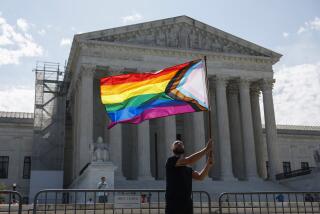Making same-sex marriages count
- Share via
When same-sex couples wed in California and Massachusetts, they do so believing that their marriage licenses mean that their relationships finally count in the eyes of the state. Unfortunately, they won’t count in the eyes of the U.S. Census Bureau.
According to its mission statement, the Census Bureau “serves as the leading source of quality data about the nation’s people.” Well, not all of the people, it turns out. Census Bureau procedures essentially hide legally married lesbian and gay couples by altering their truthful responses about their relationship.
The Census Bureau argues that the federal Defense of Marriage Act -- which defines marriage as solely between a man and a woman for all purposes related to federal regulations -- prohibits it from recognizing same-sex marriages. For the 2010 survey, the bureau intends to maintain the policy established in 2000, whereby it will edit the responses of married same-sex couples. Same-sex spouses will be reported as “unmarried partners” in all census tabulations.
In 2000, before same-sex couples could legally marry anywhere in the U.S., the argument could be made that the bureau was changing responses to something more accurate. (In fact, that change was, at the time, viewed by many as an improvement. In 1990, the bureau edited the sex of any same-sex spouses, thereby transforming the same-sex couple into a different-sex married couple.) Rather than completely editing them out of the data, the 2000 census included them in counts of same-sex “unmarried partners.” Although that decision might have been the right one then, conditions have changed.
Today, same-sex couples can marry in California and Massachusetts, and these marriages are recognized in New York. That means more than one in five Americans lives in a state that recognizes the marriages of same-sex couples. Yet none of these legally recognized couples will show up in publicly released census tabulations. They will all be relegated to an unmarried status.
The Census Bureau has a well-deserved reputation for producing “gold standard” data of uniformly high quality -- and its accuracy is relied on by journalists, researchers and the government itself. Since 2000, more than 400 newspaper stories and scholarly journal articles have referenced the census counts of same-sex couples. Government agencies, such as the Congressional Budget Office, used census data to estimate the effect on the federal budget if same-sex couples were permitted to marry.
Bureau officials should acknowledge the reality that same-sex couples are legally married in this country -- and fix their procedures for counting and describing America’s estimated 780,000 same-sex couples and their families. They should certainly stop altering the accurate responses of same-sex couples who describe themselves as married.
Decisions about data collection should not be driven by political and value-laden judgments about marriage. They should be grounded in the demographic and legal realities of this nation. Regardless of how one feels about the recognition of gay men and lesbians, all sides in these debates could benefit from accurate data. Taking steps to improve data quality on same-sex couples would permit scholars, policymakers and the American public to form opinions based on facts instead of anecdotes and stereotypes.
More to Read
Sign up for Essential California
The most important California stories and recommendations in your inbox every morning.
You may occasionally receive promotional content from the Los Angeles Times.










